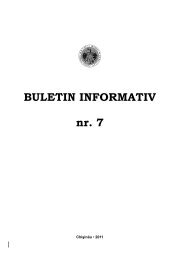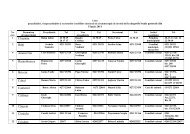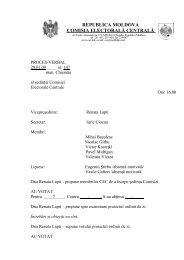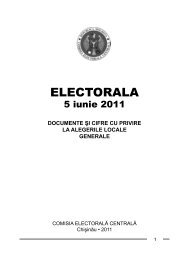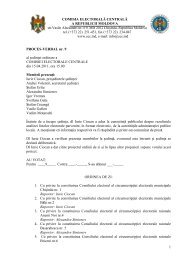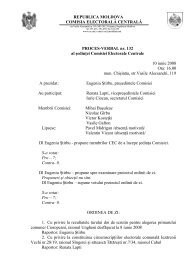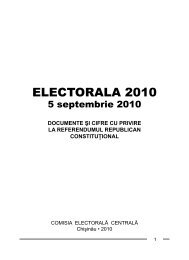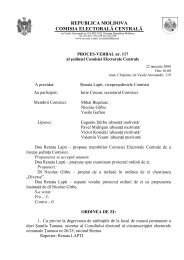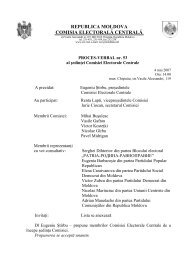noile tehnologii în formarea Åi utilizarea listelor electorale ... - Cec.md
noile tehnologii în formarea Åi utilizarea listelor electorale ... - Cec.md
noile tehnologii în formarea Åi utilizarea listelor electorale ... - Cec.md
- No tags were found...
Create successful ePaper yourself
Turn your PDF publications into a flip-book with our unique Google optimized e-Paper software.
200<br />
Conferinţa internaţională.<br />
NOILE TEHNOLOGII ÎN FORMAREA ŞI UTILIZAREA LISTELOR ELECTORALE. EVOLUŢII ŞI PERSPECTIVE<br />
stations to which no communication at all can be provided, they are on mountain<br />
tops, where, in my view, there will not be cases of multiple voting, but any solution<br />
that we try to implement must be the same for all stations. The logistical<br />
weight of such a project is devastating for a single institution, such a project can<br />
only succeed if several institutions will collaborate. Even in this pilot project there<br />
is a protocol signed with seven institutions, of which the most important is the<br />
support we receive from the School Inspectorate which provides us with the necessary<br />
computers in polling stations, and personnel necessary to operate those<br />
computers and their applications.<br />
From the architectural point of view, it’s pretty simple, we have the 61 stations<br />
that are connected to the PEA server as back-up to the Internet connection. We<br />
can also use SMS text messages, text messages sent to a unique number are taken<br />
over automatically, they contain only the personal identification number of<br />
each voter present at the polls regardless of whether sent from a computer or<br />
a mobile phone. The message returned to the operator can be like: valid voter –<br />
may vote, is on the voter list in position X on page Y, or it can be a message like:<br />
the voter cannot vote, was denied the right to vote. When the chairman of the<br />
polling station, if he/she wants more details, can contact the people from the call<br />
centre and will receive clear information why that voter cannot vote, according to<br />
what court decision, and will be told clearly why. They can receive the message:<br />
the voter has voted at polling station 700 at 10 o’clock and was recorded in the<br />
system by certain operator.<br />
The chairman of the polling station can contact either the call centre, or directly<br />
the respective station to check whether that voter really voted more than once or<br />
it was just a system error. We were speaking a little earlier about the case when<br />
one operator can enter CNPs or personal data, registers voters only because he/<br />
she wants to do harm, or to prevent someone from voting.<br />
There is a good methodology that can avoid such cases, also call centre operators,<br />
following a written request, sent via a messaging system from the level of polling<br />
station, any call centre operator may remove a record, records can be deleted<br />
from the call centre level, deleted apparently, they will simply be transferred to<br />
another state, for the traceability of all operations in the system nothing is deleted,<br />
they will pass to another state, so that the voter is allowed to vote.<br />
In terms of securing the system, all computers used to centralize these data have



